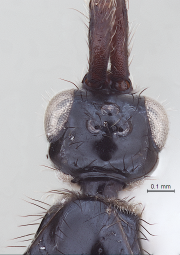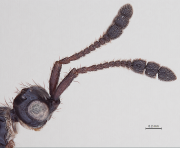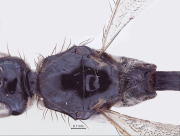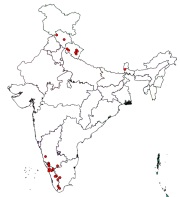 Fig 1. Female, dorsal view |
 Fig 2. Body profile |
 Fig 3. Head, dorsal view |
 Fig 4. Antenna (female) |
 Fig 5. Antenna (male) |
|
 Fig 6. Forewing |
 Fig 7. Mesosoma, dorsal view |
 Fig 8. Metasoma and petiole |
 Fig 9. Distribution map |
|
Nomenclature
Basalys Westwood, 1832: 342-344. Type species: Basalys fumipennis Westwood.
Ceratopria Ashmead, 1893: 407, 42, Synonymized by Masner, 1964: 85.
Acidopria Kieffer, 1913: 442. Synonymized by Masner, 1964:85.
Nesopria Muesebeck and Walkley, 1956: 319-419. Synonymized in Krombein et.al., 1979: 1144.
Praeloxotropa Szabo, 1979: 276.
Diagnosis
Generally 1-2.5mm long, both delicate and robust forms met with. Head and body blackish brown to black, with appendages much lighter in colour. Body smooth and shining, lacking micropilosity, but with sparse long semierect hairs, never with foamy structures on postgena, propleuron or ventral petiole. Hairy cushion often well developed on postgena, sides of pronotum and upper part of propleuron.
Head quadrangular or subglobose or even subangular. Antennal shelf often well developed. Antennae 12-segmented in females and 14-segmented in males. Female antennae with distinct, abrupt and often massive clava, number of claval segments variable from 3-5, apical segment subequal to penultimate one. Male antennae filiform, segment 3 subequal to 4, A4 modified, slightly emarginate, often carinate. Vertex sometimes armed with 1-3 spines. Eye size variable. Mandibles usually normal and bidentate.
Cervix distinct. Pronotal shoulders angulate. Mesoscutum with notauli usually absent. Propleuron densely hairy. Anterior scutellar pit monofoveate, pits subrectangular or subcircular, rarely pits absent. Lateral and posterior scutellar pits often absent, sternaulus either present or absent. Dorsellum with three median keels, propodeum sometimes elongate, with dense pilosity laterally, area between propodeum and lateral carinae (plicae) almost glabrous and bare. Median keel anteriorly produced like a tooth or spine, often with a dorsal hyaline semitransparent zone, nucha indicated in some cases.
Wings fully developed or extremely reduced. Venation surpassing one-third of forewing length in forewings, submarginal vein moderately close to costal margin, costal cell clearly indicated. Marginal vein short, postmarginal absent and stigmal vein very much reduced. If wings are fully developed, basal vein always indicated, tubular, straight and slanting. Marginal cilia reduced, length only about one-eighth of forewing width, submarginal vein on hind wings complete.
Petiole cylindrical, always longer than wide, less hairy and usually with distinct longitudinal striae. Metasoma elongate and oval. Anterior margin of T2/large tergite elevated above level of petiole, feebly concave medially and without a median furrow or emargination. Basal tergites compressed under large tergite, visible as narrow rings only.
Geographic Distribution
See distribution map (Fig.9).
Species known from India
1. Basalys besucheti Huggert
2. Basalys bispinosus Rajmohana & Narendran
3. Basalys chotti Rajmohana & Narendran
4. Basalys geoides Huggert
5. Basalys geus Huggert
6. Basalys karnatakensis (Sharma)
7. Basalys lobeli Huggert
8. Basalys mandibularis Rajmohana & Narendran
9. Basalys nilgiriensis (Sharma)
10. Basalys unicus Rajmohana & Narendran
Remarks
Very common in collections, particularly in yellow pan traps. This genus can be distinguished from other genera of Diapriinae like Trichopria Ashmead having 12 and 14 segmented antennae in females and males, respectively, by the following characters: (1) Short robust body; (2) Mandibles normal, bidentate; (3) Antenna 12-segmented in females, with an abrupt clava, 14-segmented in males; (4) Notauli absent; (5) Anterior scutellum monofoveate; (6) Area on propodeum between median keel and lateral keels (plica) almost glabrous; (7) Forewings either fully developed or very much reduced (brachypterous), but with complete venation, basal vein always distinct in fully winged forms.
Some species in the New World have opisthognathous mouthparts (Masner and Garcia, 2002), but such forms are not yet reported from India.
References
Ashmead, W. H. 1893. Monograph of the North American Proctotrypidae. United States National Museum Bulletin 45: 1-472.
Kieffer. J. J. 1913. Serphides des Îles Philippines. Insecta, 3: 253-462.
Krombein K. V. etal 1979. Catalog of Hymenoptera in America north of Mexico. in: Catalog of Hymenoptera in America north of Mexico. Volume 1, Symphyta and Apocrita (Parastica). Smithsonian Institution Press. xvi+1198 pp.
Masner, L. 1964. A comparison of some Nearctic and Palearctic genera of Proctotrupoidea (Hymenoptera) with revisional notes. Cˇ asopis Cˇ eskoslovenske´ Spolecˇnosti Entomologicke,´ 61: 123-155.
Masner, L and Garcia, J.L. 2002. The genera of Diapriinae (Hymenoptera: Diapriidae) in the New World. Bulletin of the American Museum of Natural History, 268: 1-138.
Muesebeck C. F. W and Walkley, L.M. 1956. Type species of the genera and subgenera of parasitic wasps comprising the superfamily Proctotrupoidea (order Hymenoptera). Proceedings of the United States National Museum, 105: 319-419.
Rajmohana, K and Bijoy, C., 2012. A checklist of Diapriidae and Proctotrupidae (Hymenoptera: Insecta) from India.
Szabó, J.B. 1979. Neue Arten und Fundortangaben der mongolischen Diapriiden (Hymenoptera, Diapriidae). Annales Historico-Naturales Musei Nationalis Hungarici, 71: 273-278.
Westwood, J. O. 1832. Descriptions of several new British forms amongst the parasitic hymenopterous insects. London & Edinburgh Philosophical Magazine and Journal of Science 1: 127-129.
|